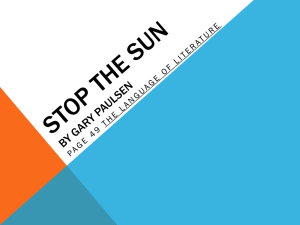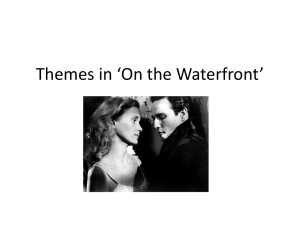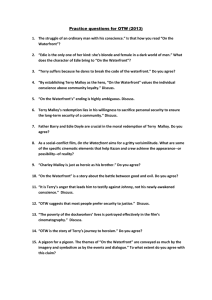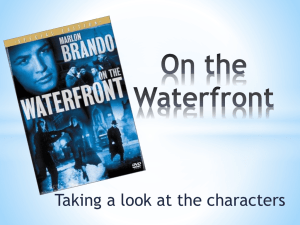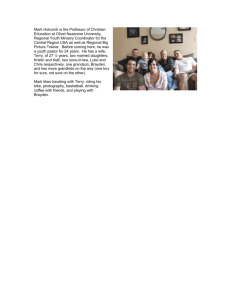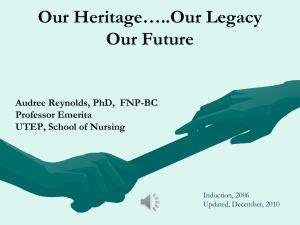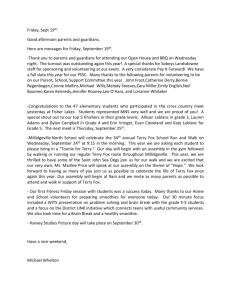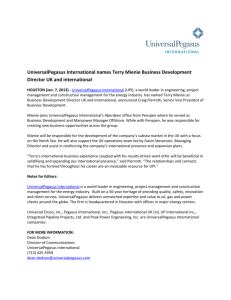Assignment
advertisement
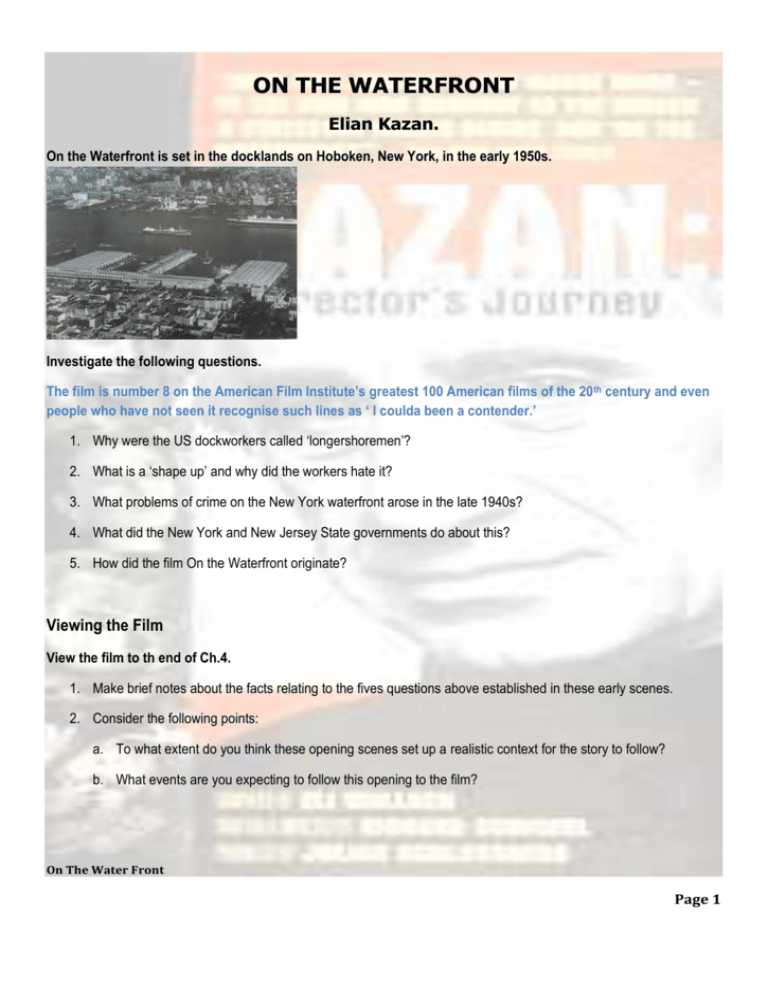
ON THE WATERFRONT Elian Kazan. On the Waterfront is set in the docklands on Hoboken, New York, in the early 1950s. Investigate the following questions. The film is number 8 on the American Film Institute’s greatest 100 American films of the 20 th century and even people who have not seen it recognise such lines as ‘ I coulda been a contender.’ 1. Why were the US dockworkers called ‘longershoremen’? 2. What is a ‘shape up’ and why did the workers hate it? 3. What problems of crime on the New York waterfront arose in the late 1940s? 4. What did the New York and New Jersey State governments do about this? 5. How did the film On the Waterfront originate? Viewing the Film View the film to th end of Ch.4. 1. Make brief notes about the facts relating to the fives questions above established in these early scenes. 2. Consider the following points: a. To what extent do you think these opening scenes set up a realistic context for the story to follow? b. What events are you expecting to follow this opening to the film? On The Water Front Page 1 Understanding the Main Characters. Taking the point of view of another character, a reporter or an observer, write about each character. Select adjectives to describe each character from the character word bank below. You can create your own words and phrases if you wish. Angelic Derisive Malevolent steadfast Anxious Determined Merciless suave Articulate Discontented Murderous Tender Base Educated Oily Tender hearted Brutal Ethical Passionate Tormented Calculating Fearless Perplexed Tough Cold blooded Guilty Principled Tyrannical Committed Heroic Rapacious uncompromising Corrupt Hesitant Remorseful unethical Courageous Humiliated Righteous Unscrupulous Criminal Inarticulate Ruthless Upright Crooked Innocient Sarcastic Villainous Decent Intimidating Shocked Violent Defiant Loving smooth Terry Malloy 1. Why do you think Terry objects to being called a ‘bum?’ 2. Why do you think he becomes angry when Edie talks about ‘conscience?’ 3. What is the moral dilemma Terry faces? Express it in on sentence. 4. How does he resolve this dilemma? 5. Why does Father Barry punch Terry? What is the significance of this punch? 6. ‘The Terry Malloy I know and admire’ As Father Barry, describes the qualities you saw in Terry On The Water Front Page 2 Edie Doyle 1. In what ways does the character of Edie complement Terry Malloy? 2. ‘In some ways, given the tough Terry or Father Barry.’ What evidence statement? waterfront culture, she is as brave a from the film might support this 3. What do you think attracts Edie to Terry Malloy? 4. What do we learn about Edie’s state of mind from her clothes and hair? 5. As Pop Doyle, describe Edie and why you admire her and fear for her. Johnny Friendly 1. How is this character able to command silence and passivity from the longshoremen? 2. Why do you think he has Charley Malloy murdered but not Terry? 3. ‘They’re dusting off the hot seat for me.’ What does Friendly have to fear from the Waterfront Crime Commission? 4. As WCC investigator Glover, describe Johnny Friendly. Father Barry 1. In the early scenes, Father Barry seems on the margin. How and why do you think he becomes so involved? With what sharp words does Edie challenge him (Ch.3) 2. Replay the priest’s speech over the dead Dugan (ch.16) What do you think is remarkable about this action? 3. As Edie and Terry, describe the qualities displayed by Father Barry. 4. When Father Barry approaches Terry in the bar, he says, ‘Now don’t give me a hard time.’ How would you describe this way of speaking to Terry? 5. Why is it significant that Father Barry refuses to hear Terry’s confession? On The Water Front Page 3 6. Why is there a second priest in the film? Charley ‘The Gent’ Malloy 1. How does Charley try to protect Terry? 2. Did Charley destroy Terry’s boxing career and turn him into ‘a bum?’ If so, how? 3. Do you think he is ‘torn between the mob and his family?’ If so, when does he show this? 4. What do the bullet holes in Charlie’s coat suggest about the way he has been killed? 5. Does Pop’s description of Charlie match our experience of him? 6. As Father Barry or Edie, describe Charley Malloy. Timothy J. ‘Kayo’ Dugan 1. Why do you think Dugan does not obey the D & D code of the waterfront? 2. What kind of role for Dugan is established in the shape-up scene at the end of chapter 4 and the church meeting (ch.6) 3. As Assisting Counsel at the Crime Commission, describe Dugan and why he was killed. Understanding the Minor Characters Study the minor characters in the film and make notes about the questions below. Pop Doyle 1. Why do you think Pop Doyle does not do or say anything about the killing of his son, Joey? 2. Why does he want Edie to go back to the nuns? 3. What action by Pop symbolises Friendly’s loss of power? 4. Why is Pop given the words, ‘he don’t need a doctor, he needs a priest?’ 5. Why does Elia Kazan place Pop on the tray that lifts Dugan’s body out of the hold? 6. Why does the director choose Pop to push Friendly into the river? Truck and Tillio 1. What do these characters do for Johnny Friendly? 2. How does Truck react to Father Barry’s sermon? 3. Why does Terry punch Tillio during Father Barry’s sermon? 4. What might Truck have done to Terry? How do you know? On The Water Front Page 4 Big Mac 1. What does Big Mac do as the boss of the shape up? From which angles does the camera shoot him in the ‘Shape Up?’ 2. Not wearing his hat? What does Big Mac do when handing out the tabs? Describe. 3. What is his opinion of Terry? How does he anger Terry? 4. What role does he play in Dugan’s killing? JP 1. ‘He won’t take no loans,’ says JP to Friendly. What does he mean? 2. What role on the waterfront does JP play for the mob? 3. What dos Friendly call JP in the bar back room scene? Glover 1. What is Gover’s job? 2. Replay the scene on the roof with Terry and the pigeons. Listen to the music. What does it evoke? 3. How does Glover gain Terry’s confidence? 4. ‘Glover is a clever and persistent operator.’ Do you agree/ If so why? Tommy 1. Tommy has a great respect for Terry early in the film. Why does he lose this? How does he show this loss of respect? 2. What does this suggest about the influence of the mob? On The Water Front Page 5 Themes. Consider the quotation and the statement of a theme in each box below. How close are the statements below to your own reading of the themes of the film? Under the heading of each theme, write responses to the statement and to the questions besides each box. Identity ‘I coulda been somebody... a contender.’(Terry) To the charge of ratting on his union mates, Terry Malloy voices the realisation that has finally come to him. Who do you think Terry blames for his reputation as a ‘bum’? Why? What do you think he means by ‘rattin’ on himself? Why do you think he finally rejects the labe of ‘bum’? ‘I’m standing over here now. I was ratting’ on myself all those years. I didn’t even know it.’ Coming to know this has given him a new sense of identity, no longer accepting the epithet of ‘just a bum.’ His relationship with the angelic Edie plays no small in this realisation What corrupt practices does the back-room scene reveal? Power and Greed. Why are Joey Doyle and Dugan killed? ‘What’s wrong with our waterfront? It’s the love of a lusy buck..more important than the love of man.’ (Father Barry) Why is Charley killed? Why does the mob view Terry’s attachment to Edie as an ‘unhealthy relationship.’ In the back room of his bar, Johnny Friendly, boasts about his corrupt practices and chides Terry for his stunned silence over the murder of Joey Doyle. Later, Friendly tells Terry that his attraction to Edie is an ‘unhealthy relationship.’ The power of being the boss has warped his sensibilities. Conflict: Truth and Silence. ‘I want to know who killed my brother.’(Edie) ‘Why don’t you tell her?’ (Father Barry to Terry.) Terry Malloy is torn between his love for Edie and loyalty to his brother Charlie and the mob; by the knowledge of his role in murder and his conscience; by the desire to tell the truth and knowing that, if he does, his life; ain’t work a nickel.’ On The Water Front Page 6 Charlie tries to bribe him to be D & D; to ‘say nothing and do nothing.’ Telling the truth and bearing the inevitable suffering make Terry a noble and heroic figure. Why do you think Terry decides to tell the truth to the Commission? Why does talk about conscience make him angry? Do you think he was concerned about saving others? Why or why not? Redemption ‘I thought the worst they was gonna do was lean on him a little bit.’(Terry) For much of the first few scenes, Terry Malloy is a study in shocked silence as he listens to the macabre jokes of the union thugs laughing about the death of the ‘canary’, Joey Doyle. Anybody who mentions the word ‘conscience’ earns Terry’s swift, angry response. This is a sign of the guilt of someone realising he is deeply involved in evil. Compare the Terry you see in the early scenes with the character on the ramp outside the union office near the end of the film. What is the difference about how he looks and what he says? In what ways does Terry earn personal redemption by the end of the film? Is this just in his own eyes? Rebirth: The Hero Redeemed Each of the ideas or themes suggested above is a way of interpreting the film. However, some of the themes of the film can be encompassed in the overarching idea of rebirth. Here is a quotation from The Seven Basic Plots (Christopher Booker, Continnum 2005) about the typical features of a ‘rebirth’ plot. ‘Everything (in the story).. hinges on a final liberation by the power of love.. the hero is the central imprisoned girue of the story, trapped by dark enchantment, and it is the heroine who eventually liberates him.’(pg.195) In what ways do you think this statement is true of the plot of On the Waterfront? Which of the themes above can you connect with the main theme of rebirth as played out in the plot of the film. How? On The Water Front Page 7 On The Water Front Page 8
